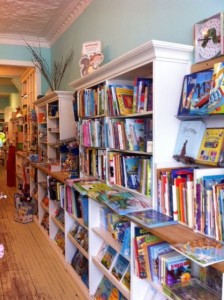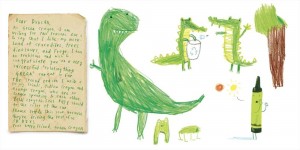August 14, 2013
Destination Bookshop: Ella Minnow Books
Destination Bookshop is a new feature here at Pickle Me This! Part book-shopping-spree, part city travel guide, we want to inspire you to visit vibrant neighbourhoods all over the Toronto with excellent bookshops as a chief attraction.
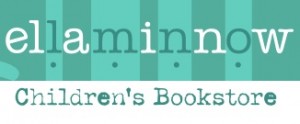 Ella Minnow Children’s Bookstore brought us to the Beaches one day in late July. Located on Queen Street East just east of Woodbine, the shop was definitely worth the journey and situated in a neighbourhood with so many excellent things to do.
Ella Minnow Children’s Bookstore brought us to the Beaches one day in late July. Located on Queen Street East just east of Woodbine, the shop was definitely worth the journey and situated in a neighbourhood with so many excellent things to do.
The Shop: We were warmly greeted upon entering Ella Minnow, and informed that as this was our first visit, we should probably start at the back of the shop and work forward. This was especially exciting because it was in the back that we met the resident rabbit, a white bunny called Marshmallow.
The shop is well-organized, with books for older readers at the back and picture books and those for younger readers at the front. The feel is definitively maximalist, charmingly cluttered even. I love the worn wooden floor. Books are everywhere, displayed facing out and also by spine like a library. Stock is carefully curated for quality, and not a Disney princess in sight. Bewarned that the shop does sell toys, but they’re pretty good ones, and many are bookish tie-ins. I’m always up for a bit of Mo Willems plush.
They’ve got new releases, lovely hardbacks, vintage paperbacks (a wide range of Virginia Lee Burton, I notice approvingly) and a good selection of Canadian authors/illustrators and small presses. After some debate, we settle on Read Me a Story, Stella, the new book by Marie-Louise Gay.
Ella Minnow was a pleasure to explore, and we could have played all afternoon, but there was more to do…
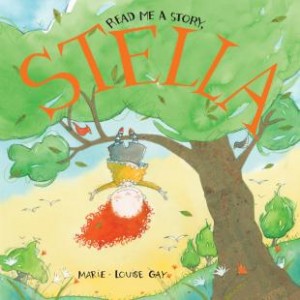 Where to Play: Kew Gardens is a fantastic park just east on Queen Street. The park features an excellent playground with a fun climbing structure, beautiful shady trees, lots of room to rove and explore and so much going on–it’s quite the community hub. We made our way through the park down to the beach on the shore of Lake Ontario, and bumped along the boardwalk. On good days, the beach is great for swimming, though it was more of skipping stones day when we were there.
Where to Play: Kew Gardens is a fantastic park just east on Queen Street. The park features an excellent playground with a fun climbing structure, beautiful shady trees, lots of room to rove and explore and so much going on–it’s quite the community hub. We made our way through the park down to the beach on the shore of Lake Ontario, and bumped along the boardwalk. On good days, the beach is great for swimming, though it was more of skipping stones day when we were there.
When you get back to Queen Street, make a wee stop at the Beaches Library, a beautiful building and one of the city’s historic Carnegie Branches.
And of course, there are plenty of fun and interesting shops along Queen Street.
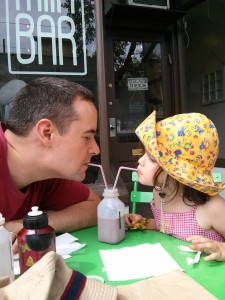 Where to Eat: Attracted by a sign promising free ice cream with lunch sets, we had lunch at Thai House Cuisine (2213 Queen Street East), and it was delicious. Snack-wise, Ella Minnow is well-situated with a Dufflet Cafe next door and even a door between them–great for a cake and a coffee or tea. And don’t miss milk and cookies at Moo Milk Bar.
Where to Eat: Attracted by a sign promising free ice cream with lunch sets, we had lunch at Thai House Cuisine (2213 Queen Street East), and it was delicious. Snack-wise, Ella Minnow is well-situated with a Dufflet Cafe next door and even a door between them–great for a cake and a coffee or tea. And don’t miss milk and cookies at Moo Milk Bar.
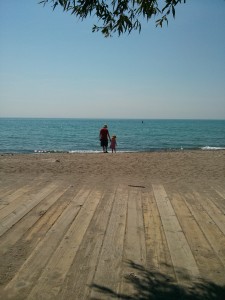 How to Get There: You can get to The Beaches by transit, on the Queen Streetcar (a [slow] adventure in itself) or by taking a bus south from eastern stations on the Danforth line. We elected to drive, however, as these days we travel with a baby and a ton of stuff. The trick of driving, however, is parking, which is hard to come by in the ‘hood, and also that the narrow, congested streets are busy and traffic is slow. This is one of those rare “it’s the destination, not the journey…” situations.
How to Get There: You can get to The Beaches by transit, on the Queen Streetcar (a [slow] adventure in itself) or by taking a bus south from eastern stations on the Danforth line. We elected to drive, however, as these days we travel with a baby and a ton of stuff. The trick of driving, however, is parking, which is hard to come by in the ‘hood, and also that the narrow, congested streets are busy and traffic is slow. This is one of those rare “it’s the destination, not the journey…” situations.
So what else are we missing? What other great things lie within the vicinity of Ella Minnow? Let us know in the comments in order to make Destination Bookshop all the more comprehensive.
August 13, 2013
Going Out With Harriet
 During the last weeks of my pregnancy and in the six weeks after Iris’s birth, I wasn’t able to pick up Harriet, and when I was finally permitted to pluck her up again, there was no plucking about it–she’d become enormous. Part of this is actually true–I think a growth spurt took place somewhere around her fourth birthday. And the rest of it is that I spend my time carrying about someone who weighs just ten lbs, and so Harriet at four times the size really is quite large. Once in a while I become struck by her massive nostrils and monstrous thighs, a logical consequence of spending much of my time staring at parts that are baby-sized.
During the last weeks of my pregnancy and in the six weeks after Iris’s birth, I wasn’t able to pick up Harriet, and when I was finally permitted to pluck her up again, there was no plucking about it–she’d become enormous. Part of this is actually true–I think a growth spurt took place somewhere around her fourth birthday. And the rest of it is that I spend my time carrying about someone who weighs just ten lbs, and so Harriet at four times the size really is quite large. Once in a while I become struck by her massive nostrils and monstrous thighs, a logical consequence of spending much of my time staring at parts that are baby-sized.
We have been lucky this summer that we’ve had as many parents as kids around all day so that Harriet has not had to suffer too much of a dearth of attention. Though her need for attention has certainly ramped up since her sister arrived, but I am getting the sense that things are settling down and in a few weeks, our whole lives are going to be constructed around Harriet’s school day as much as the presence Iris anyway.
But I have missed Harriet. This I wasn’t conscious of until our week at the cottage when Harriet was often at loose ends, and we ended up spending more time together than we had since the baby came. “Oh, this!” I thought as we worked on her sticker book, when we played “Motor Boat” in the water, had a rainy day picnic on our cottage floor. While I would never say that Harriet and I have a special bond that does not include her father, it is true that we spent most of her entire life together from 9-5, Monday to Friday. And it was very nice to spend that time together again. Nice for her, sure, but nice for me too. It had been awhile.
Yesterday, Iris was asleep in Stuart’s arms and I was suddenly compelled to visit the bookstore. “Come with me!” I asked, and she agreed once I’d promised to buy her a book to make the journey worthwhile. And so off we went, her hand in mine (which remains the greatest privilege of my life), her new purple boots on. We tramped up Brunswick to Bloor, and along the street to Book City, whose staff are some of the loveliest people around. Harriet walks around the store as if she owns it, marching right up to the carousel of paperback books she continually lusts after. The carousel of paperback books I usually never buy, because they’re not real books, I tell her. Not like the picture books proper on the shelf. Commercial tie-ins, I tell her. These books are only toys.
But while Harriet appreciates a good hardback as much as anybody, she is just as devoted to toys, so this argument doesn’t sway her. We buy books from the carousel from time to time, rooting past the Doras (which, thankfully, Harriet has never shown any interest in) and Thomas’s in search of something really good. But this time her attention was caught by a Superman I Can Read book–she is currently very much into Superheros, thanks to The Incredibles and her Daddy’s collection of Spiderman t-shirts. We looked through the Superhero books and I was ecstatic to find Wonder Woman. Harriet leafed through the book and was excited to see an illustration of her carrying a shield. “A shield!” she said. “They have those in How to Train Your Dragon.” There was even a dragon in it, plus the book was $5.
Wonder Woman is iconic in a way that Dora the Explorer will never quite manage to be, plus hers is the ultimate princess story: a princess who didn’t want to be a princess but chose to fight for justice instead. My distaste for commercial tie-ins is fickle. I was happy to buy Harriet that book, and picked up the book I had arrived for: How to Get Along with Women by Elisabeth De Mariaffi. I am also happy because Harriet is now obsessed with Wonder Woman–at 2:30am, Stuart went downstairs to her room and had to ask her to stop “reading” her new books, and go to sleep, please– which means that this morning’s outing will be to our local comic book store in search of a Wonder Woman comic. Two bookstore visits in two days! Harriet has also asked if she could please be Wonder Woman for Halloween, which is the best thing ever. And even better: Harriet asking if might it be more convenient if Wonder Woman fought the forces of evil whilst wearing pants. “Why does she have to wear her underwear?” she wonders, which is a very good question.
But the point of all this is not even books or bookstores, or Wonder Woman. It’s about the joy of walking down the street with my big girl, just the two of us. With all the changes in our lives, what stays constant is that she is excellent company.
August 9, 2013
How the Reading Stacked Up
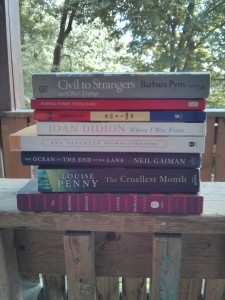 Thankfully, the black clouds that hung over our vacation at the cottage were literal rather than metaphorical. I’m also glad I didn’t have to be on vacation with a newborn in a heat-wave. It was a funny week, each of wearing the one sweater we’d brought with us every single day. Harriet didn’t have as many playmates as in recent summers, and it was also strange to be on vacation when nobody in the family is working. We didn’t get that same sense of glorious reprieve, but we did get a lot of ice cream, Harriet rode a pony, and I got a lot of reading done. We had to settle for a week away that was good rather than miraculously brilliant, and so we did. We are quite heroic.
Thankfully, the black clouds that hung over our vacation at the cottage were literal rather than metaphorical. I’m also glad I didn’t have to be on vacation with a newborn in a heat-wave. It was a funny week, each of wearing the one sweater we’d brought with us every single day. Harriet didn’t have as many playmates as in recent summers, and it was also strange to be on vacation when nobody in the family is working. We didn’t get that same sense of glorious reprieve, but we did get a lot of ice cream, Harriet rode a pony, and I got a lot of reading done. We had to settle for a week away that was good rather than miraculously brilliant, and so we did. We are quite heroic.
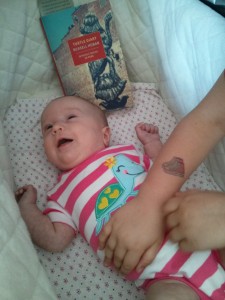 I read the short stories in the Barbara Pym book in the days before we left. Upon arrival, Russell Hoban’s Turtle Diary was first up, which Jared Bland writes about in the Globe this week. It’s a difficult, funny and terribly sad novel, just the kind of novel you’d think the man who wrote Frances would author. Though I found the ending strangely uplifting, and I wasn’t sure if I was supposed to. I reread Joan Didion’s Where I Was From next, my first reread, and I adored it. It was fascinating to see it in the context of Blue Nights and Magical Thinking, in the context of a trilogy. Her California is my land of dreams. I read The City is a Rising Tide next, the novel by Rebecca Lee whose Bobcat and Other Stories has so enchanted me. Truth was this was really a very long short story instead of a novel, but I loved it because I’ve become quite fond of Rebecca Lee’s writing and there it was. An ARC of Ann Patchett’s essay collection next, and you’ll be hearing more from me on that in the future. And then Neil Gaiman’s The Ocean at the End of the Lane, which seems to be the book of the summer in my circles. I really don’t do fantasy, and any exposure I have to fantasy underlines this (A Wrinkle in Time notwithstanding, curiously), but the Gaiman book was short and its realist elements were so compelling. I loved it. Perhaps my problem with fantasy is that all the novels are 800 pages long.
I read the short stories in the Barbara Pym book in the days before we left. Upon arrival, Russell Hoban’s Turtle Diary was first up, which Jared Bland writes about in the Globe this week. It’s a difficult, funny and terribly sad novel, just the kind of novel you’d think the man who wrote Frances would author. Though I found the ending strangely uplifting, and I wasn’t sure if I was supposed to. I reread Joan Didion’s Where I Was From next, my first reread, and I adored it. It was fascinating to see it in the context of Blue Nights and Magical Thinking, in the context of a trilogy. Her California is my land of dreams. I read The City is a Rising Tide next, the novel by Rebecca Lee whose Bobcat and Other Stories has so enchanted me. Truth was this was really a very long short story instead of a novel, but I loved it because I’ve become quite fond of Rebecca Lee’s writing and there it was. An ARC of Ann Patchett’s essay collection next, and you’ll be hearing more from me on that in the future. And then Neil Gaiman’s The Ocean at the End of the Lane, which seems to be the book of the summer in my circles. I really don’t do fantasy, and any exposure I have to fantasy underlines this (A Wrinkle in Time notwithstanding, curiously), but the Gaiman book was short and its realist elements were so compelling. I loved it. Perhaps my problem with fantasy is that all the novels are 800 pages long.
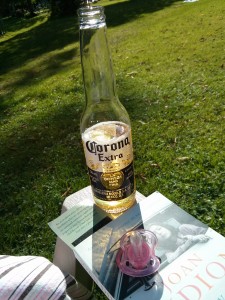 We’d already made our annual pilgrimmage to Bob Burns Books in Fenelon Falls, Stuart picking up a stack of Terry Pratchetts, Harriet getting a couple of picture books as well as a Vinyl Cafe story collection (Stuart remarks that we’re trying to save her from nerdom by trying to undermine her dragon obsession. I suggest her obsession with Stuart McLean is just another kind of nerdom), and I got The Round House by Louise Erdrich, which I’m going to be reading in the next few weeks. And then on Wednesday, it occurred to me that I wouldn’t be able to function unless I got my mitts on a Louise Penny book, and so we went back to Bob Burns (just before we had Afternoon Tea at the Fenelon Museum) and I got The Cruellest Month, which was so scary and wonderful. I have become a Louise Penny fanatic, and seem to have overcome my initial aversion to her weird sentence fragments.
We’d already made our annual pilgrimmage to Bob Burns Books in Fenelon Falls, Stuart picking up a stack of Terry Pratchetts, Harriet getting a couple of picture books as well as a Vinyl Cafe story collection (Stuart remarks that we’re trying to save her from nerdom by trying to undermine her dragon obsession. I suggest her obsession with Stuart McLean is just another kind of nerdom), and I got The Round House by Louise Erdrich, which I’m going to be reading in the next few weeks. And then on Wednesday, it occurred to me that I wouldn’t be able to function unless I got my mitts on a Louise Penny book, and so we went back to Bob Burns (just before we had Afternoon Tea at the Fenelon Museum) and I got The Cruellest Month, which was so scary and wonderful. I have become a Louise Penny fanatic, and seem to have overcome my initial aversion to her weird sentence fragments.
I finished The Cruellest Month at home, and then read Pym’s Civil to Strangers. And now all week I’ve been reading The Collected Stories of Grace Paley, as instructed by Ann Patchett, actually. I’ve also been busily writing, which the Paley has aided, I think.
And now we’re into August, which makes September seem almost inevitable. And the truth is, I am pretty excited. This summer has been the sweetest gift, the most wonderful dream. Iris is nine weeks old, growing so fast, and I am so grateful that we’ve had this time in which to enjoy her, her brand new babyhood, and each other. But the transition to September is going to come about naturally, I think, with Harriet beginning Junior Kindergarten, Stuart returning to work and also taking on some pretty cool new opportunities, and me returning to work at 49th Shelf. I’m actually really looking forward to it, and other exciting projects and events I’ll be involved in this Fall. Um, not to mention that I have a book coming out in the spring, which has not been so much at the forefront and I nearly forget it is really happening.
Posting here will remain irregular over the next few weeks as our family works to get the most out of summer (and as I vow to read as many books as possible before Real Life sets in again). We’ve got a trip to Toronto Island still before us, as well as a visit to the zoo, get-togethers with friends, afternoons in the park, patio lunches, the CNE, and a long weekend trip to Grand Bend with our friends. I also have a doctor’s appointment to determine just what exactly what we’re going to do about my enormous thyroid, which I am looking forward to being done with.
But why am I even telling you this? You’re not reading anyway. I know you’re outside drinking up the goodness of summer, or at least if you’re not, you should be.
July 26, 2013
Happy Summer
 You know as well as I do that we seem to be on a permanent vacation lately (see photo of Harriet at Woodbine Beach last Tuesday) but we’re heading out of town for awhile, and following week is devoted to other projects while Harriet is at day camp. So I will see you in a couple of weeks. Happy Summer!
You know as well as I do that we seem to be on a permanent vacation lately (see photo of Harriet at Woodbine Beach last Tuesday) but we’re heading out of town for awhile, and following week is devoted to other projects while Harriet is at day camp. So I will see you in a couple of weeks. Happy Summer!
July 25, 2013
Ellen’s Lion by Crockett Johnson
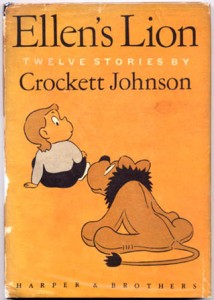 We go to the library every week or so, and I wander the stacks plucking books off the shelves with never an idea of which will “take”. Most of them are good or okay, some of them we read once and never read again, and then once in a while (and we never know when) there is a book we fall in love with. Ellen’s Lion by Crockett Johnson was such a book, though we came close to missing it altogether. It was small, old battered, and text-heavy, so Harriet never picked it up from the pile. We only started reading it when we learned that someone else had requested the book and therefore we couldn’t renew it, but it quickly became apparent that Ellen’s Lion is a book we had to own.
We go to the library every week or so, and I wander the stacks plucking books off the shelves with never an idea of which will “take”. Most of them are good or okay, some of them we read once and never read again, and then once in a while (and we never know when) there is a book we fall in love with. Ellen’s Lion by Crockett Johnson was such a book, though we came close to missing it altogether. It was small, old battered, and text-heavy, so Harriet never picked it up from the pile. We only started reading it when we learned that someone else had requested the book and therefore we couldn’t renew it, but it quickly became apparent that Ellen’s Lion is a book we had to own.
Published in 1959 and written and illustrated by Johnson (of Harold and the Purple Crayon fame), Ellen’s Lion is a book it is impossible to imagine that Mo Willems hadn’t been thinking about when he created his wonderful Amanda and her Alligator. The books are so similar in approach and tone, the story of a sparky girl and her strangely animated stuffed toy, dealing with the peculiar power dynamics between them. Though Johnson’s book is a little bit darker, Ellen’s stuffed lion a more complex character than Amanda’s alligator (and not always altogether kind). Johnson also plays interestingly with the fact that the lion’s animatedness is fuelled by Ellen’s imagination only (or is it?). There is a marvelous depth here that recalls what I love best about Arnold Lobel’s Frog and Toad.
There are few illustrations in the book, so it’s not going to appeal to everybody, but we were drawn in by the remarkable character of Ellen herself (who bears an uncanny physical resemblance to Harold). The book begins with the story “Conversation and Song”, whose opening is:
Ellen sat on the footstool and looked down thoughtfully at the lion. He lay on his stomach on the floor at her feet.
“Whenever you and I have a conversation I do all the talking, don’t I?” she said.
The lion remained silent.
“I never let you say a single word,” Ellen said.
The lion did not say a word…
Finally, the lion talks, and Ellen tries to persuade him to join her in singing a round. Oddly, it doesn’t work. It seems that Ellen and her lion are incapable to singing two different parts at once.
In the other stories, Lion rides on Ellen’s train set all the way to Arabia. Ellen phones the police to report a lion in her room, and then must hide her lion when the (imaginary?) policeman arrives. In “Two Pairs of Eyes”, Ellen uses her lion’s button eyes to look for the things in the dark she can’t see behind her. In “Doctor’s Orders”, Ellen plays doctor and tries to convince Lion that he’s a poor, ill little lion who just can’t stop smoking. Ellen tries to convince the lion that he should be a tiger when he grows up. Ellen’s acting in a play in “Five Pointed Star”, and Lion must resist her efforts to involve him in the performance. In “Sad Interlude”, Ellen tries to project great melancholy onto her lion, but he’s not playing. In “Fairy Tale”, Ellen goes from game to game, imagining she’s a fairy, then a knight, then a princess, without transitions even, all the while she is eating a muffin with raspberry jam. Her imagination is inexhaustible. And in the final story “The Last Squirrel”, a new toy threatens to displace Ellen’s Lion, but the history between girl and plush creature proves a bond too strong to sever.
There is one moment, or one word, only when this book shows its datedness. “I’m going to be a lady fireman,” Ellen shouts as she explains to lion that he’s going to be a tiger when he grows up, not her. But even the sentiment of this demonstrates the kind of book that Ellen’s Lion is, that Ellen is a strong, feisty and spirited heroine whose gender is incidental to her character (and that’s why I loved Willems’ Amanda too). I might declare that Ellen was ahead of her time, though the fact of the matter is merely that contemporary female picture book characters in general are undergoing a bit of a regression.
I love this book. We bought a used copy from Amazon for a very low price, though it’s also currently in “print” as an e-book. The really cool news, which we discovered yesterday, is that Johnson wrote a sequel to Ellen’s Lion, called The Lion’s Own Story. However this cool news takes a tragic turn–the book is not available at the library and used copies sell for $300. Has anybody read it?
July 24, 2013
The Day the Crayons Quit by Drew Daywalt and Oliver Jeffers
 “Down with this sort of thing!” screams the red crayon’s placard on the back of The Day the Crayons Quit, a new book by Drew Daywalt and illustrated by THE Oliver Jeffers. And oh, this book is funny, appealing to the little ones listening and their parents alike. More over, to those of us who are postally inclined: here is an epistolary picture book, illustrations of airmail envelopes even. They’re among a huge stack of envelopes tied up with string that Duncan discovers one day at school when he’s taking out his crayons. It turns out the crayons have quit, however, their letters voicing each of their respective protests: red is sick of the overtime, having to work through the holidays colouring Santa Claus and Valentine hearts; beige hates having everyone think he is boring (“when was the last time you saw a kid excited about coloring wheat?”); grey is exhausted from overuse, with Duncan’s affinity for elephants, hippos and whales, each of them so big; white is barely there; orange and yellow are in a feud about the colour of the sun. And so it goes, letter by letter, colour by letter, until Duncan devises a clever way to bring peace to his crayon box.
“Down with this sort of thing!” screams the red crayon’s placard on the back of The Day the Crayons Quit, a new book by Drew Daywalt and illustrated by THE Oliver Jeffers. And oh, this book is funny, appealing to the little ones listening and their parents alike. More over, to those of us who are postally inclined: here is an epistolary picture book, illustrations of airmail envelopes even. They’re among a huge stack of envelopes tied up with string that Duncan discovers one day at school when he’s taking out his crayons. It turns out the crayons have quit, however, their letters voicing each of their respective protests: red is sick of the overtime, having to work through the holidays colouring Santa Claus and Valentine hearts; beige hates having everyone think he is boring (“when was the last time you saw a kid excited about coloring wheat?”); grey is exhausted from overuse, with Duncan’s affinity for elephants, hippos and whales, each of them so big; white is barely there; orange and yellow are in a feud about the colour of the sun. And so it goes, letter by letter, colour by letter, until Duncan devises a clever way to bring peace to his crayon box.
There is a reference to nakedness and underwear, demonstrating that you can be smart and appeal to the lowest common denominator at the same time, much to my daughter’s amusement. The book is gorgeously illustrated, Jeffers’ familiar collage approach shown here as the pictures include the texture of actual pieces of paper and pages from colouring books. The crayons themselves are simply drawn, but still have enormous personality. The art they’re used to create is charmingly convincing as that made by a childish hand.
Here is a wonderful testament to the hidden lives of ordinary things, as well as to childhood creativity and the pleasures of rainbows.
July 22, 2013
Jumping the Gun
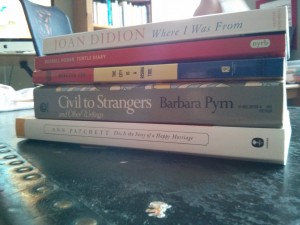 As always, the only prep I ever do before the night before we go away (or morning of, sometimes) is to select my vacations reads. Fingers crossed that Iris is partial to Muskoka chairs. And because 5 books might be a bit ambitious for a holiday with a newborn, I have started my vacation reads a few days in advance. Anyway, there you have it. A mix of fiction and nonfiction, rereads and new. And naturally, some Barbara Pym.
As always, the only prep I ever do before the night before we go away (or morning of, sometimes) is to select my vacations reads. Fingers crossed that Iris is partial to Muskoka chairs. And because 5 books might be a bit ambitious for a holiday with a newborn, I have started my vacation reads a few days in advance. Anyway, there you have it. A mix of fiction and nonfiction, rereads and new. And naturally, some Barbara Pym.
July 22, 2013
“Like life is always fucking subtle”: Americanah by Chimamanda Ngozi Adichie
 “I’m going to blog about that.”/ “I knew you’d say that.”
“I’m going to blog about that.”/ “I knew you’d say that.”
I am really excited about the forthcoming anthology Friend. Follow. Text. #storiesFromLivingOnline, which will include short fiction by Canadian authors including Jessica Westhead, Heather Birrell and Alex Leslie, featuring (I suspect…) stories which were some of my favourites from their collection–Westhead’s story that takes place in the comments section of a lifestyle blog; Birrell’s on an online pregnancy forum; Leslie’s comprised of descriptions of Youtube videos featuring a Bieber-like teen-pop sensation. Even Samantha Bernstein’s memoir in emails Here We Are Among the Living is part of this trend of authors using online and social media to change the shape of traditional literary forms, taking advantage of the uniqueness and peculiarity of online communication to contain modernity in their work, to say something new.
At first, Chimamanda Ngozi Adichie wouldn’t be the most obvious candidate to be part of this literary trend. Her previous novel Half of a Yellow Sun (which won the Orange Prize in 2007) was a sweeping epic novel about the Biafran War. She is the writer who brought me to Chinua Achebe. Adichie is Africa. She is history. Her scope is huge, when online communication can seem so ridiculous and small, so much lesser. And yet, it is also very much of this world, and it is the world that Adichie is concerned with. As she stated in a recent interview, “I love books that are social in the way that they engage with the real reality.”
In her new novel Americanah, Adichie’s protagonist is a blogger. Ifemelu is a Nigerian expat in America who has established herself as author of the blog Raceteenth or Various Observations About American Blacks (Those Formerly Known as Negroes) by a Non-American Black. She is able to make a living from her blog through advertising and speaking engagements, and has also been made a fellow of Princeton University. Her blog attracts hundreds of readers everyday with such provocative posts as “A Michelle Obama Shout-Out Plus Hair as Race Metaphor”, “Obama Can Win Only If He Remains the Magic Negro” and “Thoughts on the Special White Friend”. For Adichie’s purposes, however, the blog exists so she can include sharply-worded, strongly opinionated, polarizing ideas in her novel about race in America, ideas which have been flooding social media since George Zimmerman’s acquittal last week of murder in the death of Trayvon Martin. The blog posts–humorous, pointed and passionate–read in tone and language as very authentic, and along with the novel’s references to Facebook, email, and an online forum about natural hair, infuse the novel with a fascinating intertextuality. The blog posts in particular give the novel an edginess that straightforward fiction might be too subtle to provide.
Subtlety was an issue for me as I was reading Americanah though. While it was compelling, the story of Ifemelu and Obinze who begin as a couple in high school and each escape the “choicelessness” of life in Nigeria (for the US and UK respectively) to find their lives taking radically different trajectories, there was a hollowness to the secondary characters these two encountered. “Some of the people we met had nothing, absolutely nothing, but they were so happy,” says Ifemelu’s first American employer of a trip to India. She eventually becomes a friend to Ifemelu but also seems to exist primarily as a mouthpiece for other such asinine pronouncements. Where was the depth in these characters, I was wondering, struggling to make sense of its lack in the context of Adichie’s talent as a novelist. Though could this be part of the novel’s satire, I wondered? And if we’re going to turn the tables, is not portraying characters of a certain race as stereotypical stock characters part of an age-old literary tradition?
There was more though. I love a book so textured that the answer to my criticisms are contained inside its very pages. I reached page 335 to find a tirade by Ifemelu’s boyfriend’s sister who is about to publish her first book, a memoir about growing up black in America. She explains, “My editor reads the manuscript and says, “I understand that race is important but we have to make sure the book transcends race…” And I’m thinking, But why do I have to transcend race? You know, like race is a brew best served mild, tempered with other liquids, otherwise white folk can’t swallow it.” Explaining an anecdote, she says, “So I put it in the book and my editor wants to change it because he says it’s not subtle. Like life is always fucking subtle.”
She continues, “You can’t write a novel about race in this country. If you write about how people are really affected by race, it’ll be too obvious. Black writers who do literary fiction in this country, all three of them… have two choices: they can do precious or they can do pretentious. When you do neither, nobody knows what to do with you. So if you’re going to write about race, you have to make sure it’s so lyrical and subtle that the reader who doesn’t read between the lines won’t even know it’s about race. You know, a Proustian meditation, all watery and fuzzy, that at the end just leaves you feeling watery and fuzzy.”
Blog posts, of course, are the very opposite of lyrical and subtle. Adichie has clearly found a way around the matter.
In some ways, Adichie’s novel bears a resemblance to Zadie Smith’s NW and it’s treatment of race and London, though Adichie shrugs off Smith’s experimental approach, preferring to focus on life as lived as opposed to its voices or the complexities of point of view. The story is the point, and the ideas contained within, instead of its delivery. Ifemelu leaves Obinze when she receives a partial scholarship to an American university, though the two promise to remain connect, to not be apart forever. She arrives in America, however, to discover that the reality of life there is radically different from what she’s seen on The Cosby Show or The Fresh Prince of Bel Air. She must find a job to make ends meet, but she’s not permitted to work legally and has difficulty finding a job under the table as her accent, her appearance, and her lack of American job experience continue to stymy her efforts. She slips into a depression and is just about to hit rock bottom, which would have made this a short book if she’d managed it, when things between to happen for her. In a sense, while Adichie does not portray America or the experience of its immigrants in an easy or flattering light, she does demonstrate that the American Dream is possible, while it is not for Obinze in the UK. Though it must be noted what an exception is Ifemelu–I don’t know if it’s more likely that your average Nigerian immigrant would become a Princeton fellow or a professional blogger. In fact the odds of anyone becoming a professional blogger are unlikely.
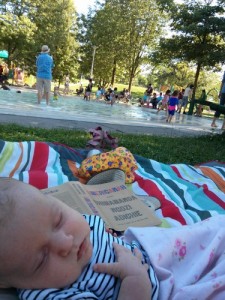 Meanwhile, Obinze’s American dreams are dashed in light of the September 11th terrorists attacks, when the US tighten their visa restrictions and make him ineligible for entry. He receives a temporary visa to England through his mother, a university professor, and when his visa expires, he remains in the country, working under the name and number of another man who’s helping himself to a portion of Obinze’s wages. He gets a job cleaning shit off toilets, and then delivering kitchens, performing the tricky maneuvre of always watching his back while trying to look forward and desperately cobble together a better future. (Here, Adiche’s explores the world of London’s underground job market for illegal migrants, as did John Lanchester in his novel Capital with his Zimbabwean traffic warden.) The ticket is an arranged marriage to a woman with an EU passport, which can be brought about with the right amount of cash (although the last time he tried this, they took off with his money). Plans fail, however, and Obinze is deported, brought home in disgrace only to discover that things are changing in Nigeria, that there is opportunity for a bright young man who is willing to play the system.
Meanwhile, Obinze’s American dreams are dashed in light of the September 11th terrorists attacks, when the US tighten their visa restrictions and make him ineligible for entry. He receives a temporary visa to England through his mother, a university professor, and when his visa expires, he remains in the country, working under the name and number of another man who’s helping himself to a portion of Obinze’s wages. He gets a job cleaning shit off toilets, and then delivering kitchens, performing the tricky maneuvre of always watching his back while trying to look forward and desperately cobble together a better future. (Here, Adiche’s explores the world of London’s underground job market for illegal migrants, as did John Lanchester in his novel Capital with his Zimbabwean traffic warden.) The ticket is an arranged marriage to a woman with an EU passport, which can be brought about with the right amount of cash (although the last time he tried this, they took off with his money). Plans fail, however, and Obinze is deported, brought home in disgrace only to discover that things are changing in Nigeria, that there is opportunity for a bright young man who is willing to play the system.
Obinze is established as a big man in Nigeria by the time Ifemelu returns after thirteen years in America, and he is by now married with a child. Neither has ever forgotten the other, though the reasons for their estrangement have become unknown or blurry with time. The stakes for their reunion are high, and in a sense Americanah‘s first 426 pages are just a prelude to this point. Because yes, this is a love story, but it’s a love story with an unabashed agenda, rich and compelling. And while Adichie confesses to not being a fan of experimental literature, it can’t be denied that with her third novel, she has broken new literary ground.
July 17, 2013
Les Ontoulu ne mangent pas les livres
 We have to thank my lovely cousin, who is my oldest and one of my dearest friends, for delivering this most remarkable picture book into our life. She’d had enough of waiting for Les Ontoulu ne mengest pas les livres to be translated into English and so gave it to us in its original French, along with her very own English translation alongside. And thank goodness she did–this book is wonderful! It is a story about the Ontoulu family (whose name translates as “Read It All”). Their home is full of literary treasures, and the parents are eager to pass on their love on books to their adorable son Lulu. Because books are their life– the Ontoulu’s read books, write books, collect books, they even eat bo– no! don’t be ridiculous! They’d didn’t eat books!
We have to thank my lovely cousin, who is my oldest and one of my dearest friends, for delivering this most remarkable picture book into our life. She’d had enough of waiting for Les Ontoulu ne mengest pas les livres to be translated into English and so gave it to us in its original French, along with her very own English translation alongside. And thank goodness she did–this book is wonderful! It is a story about the Ontoulu family (whose name translates as “Read It All”). Their home is full of literary treasures, and the parents are eager to pass on their love on books to their adorable son Lulu. Because books are their life– the Ontoulu’s read books, write books, collect books, they even eat bo– no! don’t be ridiculous! They’d didn’t eat books!
But when they do introduce books to wee Lulu, figuring that he will love them as much as they do, he promptly sticks them in his mouth. Apparently they feel so good on his teething gums, and the Ontoulu parents are horrified. “Lulu, in our family we don’t eat books,” they tell him and they take the books away until he’s finished teething.
But the next time they give him a book, he throws it on the floor–he loves the music the book creates as it lands. He draws in his picture books. He tears out the pages of a travel book to make into a kite. And his parents are exasperated, while poor Lulu really doesn’t understand both why they’re so unhappy with him and what’s the big deal about books anyway? They seem to only create problems, and besides, he’s never once managed to get to the end of a story.
One day, however, in an effort to cheer up his Papa who is sick in bed, Lulu opens up a book and begins making up a story of his own. His Papa realizes that of all the literary treasures in their home, the amazing stories that Lulu imagines are the greatest of all of them. He and his wife develop a more playful attitude toward their home library, conceding that books sometimes do indeed make fine building blocks for constructing castles and other splendid unconventional things. And with his parents’ more relaxed approach to the bookish life, Lulu begins to understand their passion and decides that he too is going to become a reader of books, a writer of books, a collector of books and an eater of bo–no! don’t be ridiculous! He’s not going to eat books.
How lovely to read a Canadian picture book in our other official language. Merci, ma cousine!
July 15, 2013
Bobcat by Rebecca Lee
I had only read the first story in Rebecca Lee’s short story collection Bobcat before I’d ordered a copy of her novel from the bookstore. Why, I wondered already, had this collection not been more hyped? Not until it was awarded the Danuta Gleed Award a few weeks back did it really come to my attention. But one story was all it took for me to realize that Lee is a writer approaching mastery of her craft. As significant, I think, as the fact that she received an MFA from the Iowa Writers’ Workshop is that she received it 21 years ago. That Lee has had time to grow and develop as a writer so she’s no ingenue, but instead her writing reveals a maturity that is most admirable. Her grasp of these stories was so firm, and her voice so strong that I knew I’d be wanting more of it. I look forward to reading her novel The City is a Rising Tide very soon.
Rebecca Lee’s short stories share the same approach as Sarah Selecky’s, the same intimate first-person narration, close attention to detail that sets these characters as very much of this world (lines like “Lizbet basically knew how to live a happy life, and this was revealed in her trifle–she put in what she loved and left out what she didn’t”)–as well as dinner-party settings and fork on the cover. But on the other side, Lee’s marvelous telescoping endings and ultimate broadness of perspective remind me of the stories in Jhumpa Lahiri’s The Interpreter of Maladies. (I think “Bobcat” may join Lahiri’s “The Fifth and Final Continent” as one of my favourite short stories ever.) These stories were written over two decades and accordingly the collection lacks a certain cohesion, except for (and this is significant) the solidity of Lee’s voice.
“One of the things Strandbakken had been struggling to teach us was that a building ought to express two things simultaneously. The first was permanence, that is, security and well-being, a sense that the building will endure through all sorts of weather and calamity. But it also ought to express an understanding of its mortality, that is, a sense that it is an individual and, as such, vulnerable to its own passing away from this earth. Buildings that don’t manage this second quality cannot properly be called architecture, he insisted. Even the simplest buildings, he said, ought to be productions of the imagination that attempt to describe and define life on earth, which of course is an overwhelming mix of stability and desire, fulfillment and longing, time and eternity.” –from “Fialta”
Lacking a certain cohesion (which in a collection this good is less a criticism than a statement of fact), yes, but there are more than a few points in common. Three of these stories take place in academic settings. These are stories written with an awareness of history and not just a general contemporariness. They are filled with allusions and references to actual places, people, and things. Though “Bobcat” is like this least of all, the first story, about a dinner party and so tightly contained within four walls that the effect is claustrophobic until the story’s incredible ending in which the whole thing explodes. A hostess is acutely aware of the inner lives and workings of her dinner guests, so much so that she’s blind to her own destiny. The people in this story are so vivid and real, and the ending was both incredible and heartbreaking. “The Banks of the Vistula” is a 1980s’ Cold War story (“But this was 1987, the beginning of perestroika, of glasnost and views of Russia were changing. Television showed a country of rain and difficulty and great humility, and Gorbachev was always bowing to sign something or other, his head bearing a mysterious stain shaped like a continent one could almost but not quite identify” [and how I love that “almost but not quite…]) about a university student who plagiarizes a linguistics paper from 1950s’ Soviet propaganda.
“Slatland” is a peculiar story about a strange psychologist and his impact on a young patient who returns to him years later looking for him to translate letters her Romanian fiance is writing to a woman whom she suspects is her fiance’s wife. In “Min”, another Midwestern university student travels to still-British Hong Kong and is enlisted with the job of selecting him a wife, as her friend’s diplomat father is being faced with the morally ambiguous task of deporting Vietnamese refugees. In “World Party”, a female professor during the 1970s’ uses her relationship with her (perhaps autistic?) son to decide the future of a male colleague who has been accused of a sexually inappropriate relationship with a student. And the final story is “Fialta”, in which architecture becomes analogous to story-writing and a group of students enrolled in an elite mentorship program fall in and out of love with one another, learn, come of age and of self, and are each uniquely bound to their teacher for better or worse.
